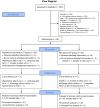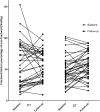Effectiveness of acute in-hospital physiotherapy with knee-extension strength training in reducing strength deficits in patients with a hip fracture: A randomised controlled trial
- PMID: 28662153
- PMCID: PMC5491058
- DOI: 10.1371/journal.pone.0179867
Effectiveness of acute in-hospital physiotherapy with knee-extension strength training in reducing strength deficits in patients with a hip fracture: A randomised controlled trial
Abstract
Question: Is acute in-hospital physiotherapy with additional progressive knee-extension strength training (ST) of the fractured limb more effective in reducing knee-extension strength deficit at follow-up compared to physiotherapy without strength training in patients with a hip fracture?
Design: Assessor blinded, randomised controlled trial with intention-to-treat analysis.
Participants: 90 patients with a hip fracture admitted to an acute orthopaedic Hip Fracture Unit at a university hospital between October 2013 and May 2015.
Intervention: Daily physiotherapy with or without progressive knee-extension strength training (10RM), 3 x 10 repetitions, of the fractured limb using ankle weight cuffs conducted by ward physical therapists during hospital stay.
Outcome measures: Primary outcome was the change in maximal isometric knee-extension strength in the fractured limb in percentage of the non-fractured limb from inclusion to postoperative day 10 or discharge (follow-up). Secondary outcome was Timed Up and Go test measured early after surgery and at follow-up.
Results: In the intention-to-treat analysis of between-group differences, the primary outcome improved 8.1% (95% CI -2.3; 18.4) by additional strength training from baseline to follow-up. In the per-protocol analysis of non-missing data, significant between-group improvements by 10.5% (95% CI 0.3; 20.7) were found in favour of additional ST. No significant between-group differences were found in any secondary outcome.
Conclusion: Physiotherapy with addition of 5 sessions of ST yielded no additional improvements compared to physiotherapy without strength training in reducing the knee-extension strength deficit at follow-up in patients with a hip fracture. It is debatable whether larger improvements than the observed 8-10% can be expected given that only five exercise sessions, on average, were completed. In fragile patients with a hip fracture in the acute phase, where the ability to participate in functional exercise is compromised, we still consider early strength training a possibility to improve outcomes of clinical importance, given the results of the per-protocol analysis. The present data provides an important basis and call for future investigations including longer term interventions.
Trial registration: Clinicaltrials.gov NCT00848913.
Conflict of interest statement
Figures





References
-
- Kristensen MT, Bandholm T, Bencke J, Ekdahl C, Kehlet H (2009) Knee-extension strength, postural control and function are related to fracture type and thigh edema in patients with hip fracture. Clin Biomech (Bristol, Avon) 24: 218–224. doi: 10.1016/j.clinbiomech.2008.10.003 - DOI - PubMed
-
- Sherrington C, Lord SR, Herbert RD (2003) A randomised trial of weight-bearing versus non-weight-bearing exercise for improving physical ability in inpatients after hip fracture. Aust J Physiother 49: 15–22. - PubMed
-
- Mitchell SL, Stott DJ, Martin BJ, Grant SJ (2001) Randomized controlled trial of quadriceps training after proximal femoral fracture. Clin Rehabil 15: 282–290. doi: 10.1191/026921501676849095 - DOI - PubMed
-
- Davenport SJ, Arnold M, Hua C, Schenck A, Batten S, Taylor NF (2014) Physical Activity Levels During Acute Inpatient Admission After Hip Fracture are Very Low. Physiother Res Int. doi: 10.1002/pri.1616 - DOI - PubMed
-
- Ziden L, Scherman MH, Wenestam CG (2010) The break remains—elderly people's experiences of a hip fracture 1 year after discharge. Disabil Rehabil 32: 103–113. doi: 10.3109/09638280903009263 - DOI - PubMed
Publication types
MeSH terms
Associated data
LinkOut - more resources
Full Text Sources
Other Literature Sources
Medical
Miscellaneous

